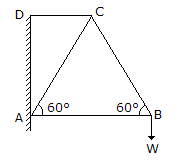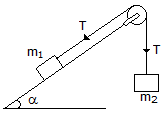Test: Engineering Mechanics - 3 - Mechanical Engineering MCQ
25 Questions MCQ Test - Test: Engineering Mechanics - 3
The point, through which the whole weight of the body acts, irrespective of its position, is known as
The loss of kinetic energy during elastic impact is zero.
| 1 Crore+ students have signed up on EduRev. Have you? Download the App |
The overturning of a vehicle on a level circular path can be avoided if the velocity of vehicle is __________  .
.
 .
.The rate of change of momentum is directly proportional to the impressed force, and takes place in the same direction in which the force acts. This statement is known as
In ideal machines, mechanical advantage is __________ velocity ratio.
The minimum force required to slide a body of weight W on a rough horizontal plane is
The moment of inertia of a square of side a about its diagonal is
The angular velocity (in rad / s) of a body rotating at N revolutions per minute is
The centre of gravity of a semi-circle lies at a distance of __________ from its base measured along the vertical radius.
The process of finding out the resultant force is called __________ of forces.
A weight of 1000 N can be lifted by an effort of 80 N. If the velocity ratio is 20, the machine is
In a framed structure, as shown in the below figure, the force in the member BC is 
The potential energy of a vertically raised body is __________ the kinetic energy of a vertically falling body.
If a number of forces acting at a point be represented in magnitude and direction by the three sides of a triangle, taken in order, then the forces are not in equilibrium.
The periodic time of a particle with simple harmonic motion is __________ proportional to the angular velocity.
A block of mass m1, placed on an inclined smooth plane is connected by a light string passing over a smooth pulley to mass m2, which moves vertically downwards as shown in the below figure. The tension in the string is 
If a given force (or a given system of forces) acting on a body __________ the position of the body, but keeps it in equilibrium, then its effect is to produce internal stress in the body.
The principle of transmissibility of forces states that, when a force acts upon a body, its effect is
A differential pulley block has larger and smaller diameters of 100 mm and 80 mm respectively. Its velocity ratio is
If three forces acting at a point are represented in magnitude and direction by the three sides of a triangle, taken in order, then the forces are in equilibrium.
Newton's second law motion __________ a relation between force and mass of a moving body.
The periodic time of one oscillation for a simple pendulum is(where l = Length of the pendulum.)

















